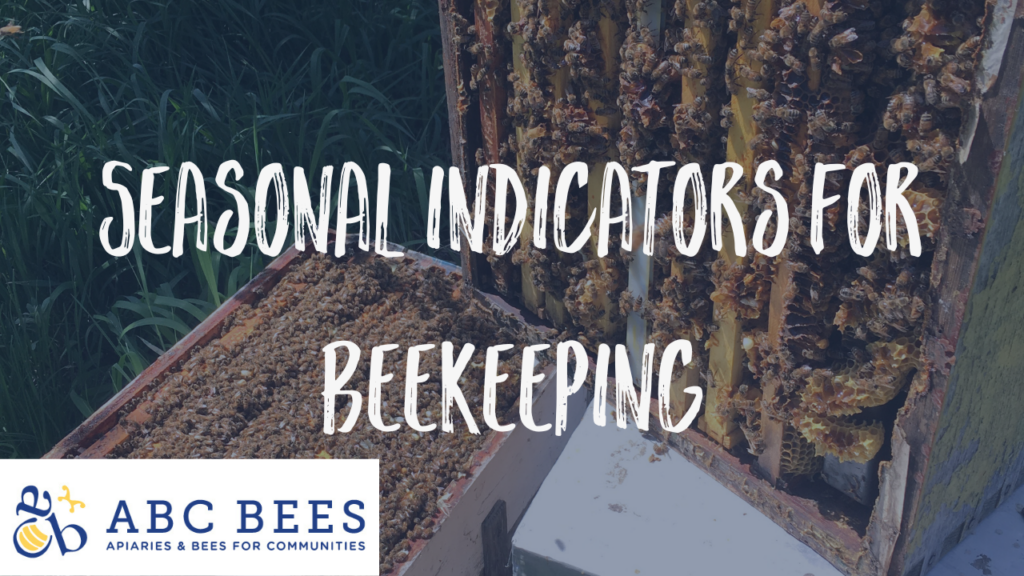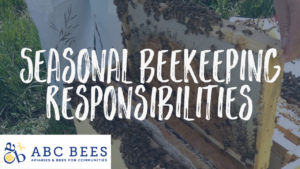Outcomes
Learners will be able to identify key seasonal indicators in beekeeping, including flow, temperature, and climate.
Key Takeaways
Flow signifies the period when nature provides abundant food for bees; it varies by region and year.
Recognizing local flora indicators of flow helps plan hive activities.
Temperature plays a crucial role, affecting tasks like inspections and medication administration.
Temperature can vary from year to year, necessitating adaptation to weather conditions.
Climate data offers a broader perspective for planning beekeeping tasks.
Anticipating temperature patterns helps beekeepers schedule activities like honey harvesting.
Success in beekeeping depends on syncing with the hive’s intricate rhythms and the environment.
In this blog post, we will delve into the significance of understanding the seasonal indicators in beekeeping. These markers, which encompass flow, temperature, and climate, empower beekeepers to anticipate their hive’s needs.
Flow
The concept of “flow” in beekeeping refers to the period when nature generously provides an abundance of food for your bees. It’s a time of plenty when nectar and pollen-rich plants are in bloom, allowing your bees to forage and store resources for the leaner times ahead. Understanding flow is essential for recognizing the season your bees are experiencing.
However, it’s important to note that the timing of these flows can be highly regional and even variable from year to year. What may be a blooming paradise for bees in spring in one area may not align with the same season in another locale. Therefore, beekeepers need to familiarize themselves with local flora and the specific indicators of flow in their respective areas.
By recognizing these floral cues, beekeepers can adjust their management practices accordingly. They can plan hive inspections, honey harvesting, and other activities during these periods of abundance, ensuring that their bees are well-nourished and thriving.
Temperature
Temperature is another crucial factor that beekeepers must consider when managing their hives. The current and projected temperatures play a pivotal role in determining when certain tasks should be undertaken. Some beekeeping activities, such as hive inspections, medication administration, or survival checks, require specific temperature ranges for optimal execution.
Moreover, temperature fluctuations can vary from year to year, making it essential for beekeepers to stay informed about local weather conditions. For instance, you might experience an unusually warm January one year, allowing you to conduct inspections and checks, while the next year, January may bring freezing temperatures.
By closely monitoring temperature trends and being prepared to adapt to unexpected changes, beekeepers can ensure the well-being of their colonies. It’s all about timing and ensuring that hive management practices are aligned with the conditions dictated by the weather.
Climate
While temperature is an immediate concern, climate provides a broader perspective that beekeepers can use to map out their beekeeping calendar. Climate data offers a predictable pattern of anticipated temperatures throughout the year, allowing beekeepers to plan their seasonal tasks more effectively.
For example, in the Canadian prairies, it’s highly unlikely to encounter minus 20-degree temperatures in July but quite expected during the harsh winter months of January. Armed with this knowledge, beekeepers can prepare for activities like harvesting honey or rearing queens during the appropriate seasons.
Conclusion
In beekeeping, success hinges on the ability to read the intricate rhythms that govern the hive. Flow, temperature, and climate are the key indicators that enable beekeepers to synchronize their efforts with nature’s cycles. By mastering these seasonal cues, beekeepers can anticipate their hive’s needs, nurture healthy colonies, and, in the process, partake in the beautiful dance that is beekeeping—a delicate interplay between the hive, the environment, and the beekeeper’s watchful eye.







